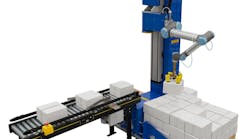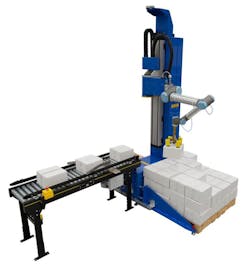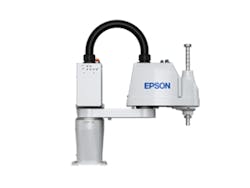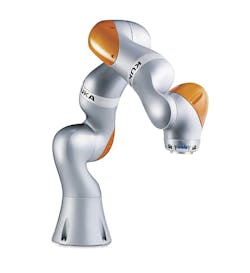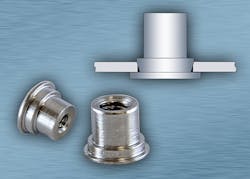Things are ramping up for this year’s MD&M West show, being held at the Anaheim Convention Center from February 6-8. Many companies use this large show to launch products, and show off their technology and capabilities. As companies set up booths and max out the surrounding area’s hotels, let’s take a look at what to expect this year. You can follow the event live on Twitter @MDM_Events, or me @JKerns10. There’s also a Facebook page where you can see MD&M West-related posts through the week.
Universal Robots: Zero Footprint Palletizer
Attendees at ATX West show, held in conjunction with MD&M West from Feb. 6-8, will get a hands-on experience of how user-friendly collaborative robots—or cobots—can now safely and effortlessly automate some of the most common manufacturing tasks in the industry. Universal Robots’ ATX Booth 4616 will be the launching pad for the Zero Footprint Palletizer (ZFP), which is ready for distribution in North America through Apex Motion Control.
The ZFP is a simple solution for mid-rate production at a maximum load of 18 lbs. The system can be easily redeployed throughout a facility, and fits into existing packaging lines without modification, replacing manual palletizing operations in minutes. The new ZFP has a vertical 7th-axis swing system with the ability to stack on each side, supporting North American pallet sizing.
“The UR10 arm was chosen for this solution due to its ease-of-use and safety features,” says Rob Antonides, President of Apex Motion Control. ”We deliver automation solutions for the food industry and saw a clear market need for a flexible automation solution that addresses high-mix/low-volume runs in space-restrained spaces.”
The ZFP can operate with no guarding. If an operator is detected in the carton pickup area, the collaborative safety features of the UR10 will reduce the speed of the robot until the area is cleared while the zero-pressure accumulation infeed conveyor controls the flow of the product.
Nelipak Healthcare Packaging: High-Performance Collaboration
At Booth 1970, Nelipak Healthcare Packaging will demonstrate a new way to utilize collaborative robotic technology in conjunction with its NX-T1 cleanroom heat tray sealer to optimize process automation. Nelipak is using the Rethink Robotics Sawyer robot with Nelipak’s NX-T1 to demonstrate high-performance automation by collaboratively working with operators handling medical device and pharmaceutical packaging. The RFID reader feature confirms correct recipe and tool-set combinations are selected; incorrect inputs result in machine lock out. The 21 CFR 11-compliant logging of inputs provides an audit trail of data.
Designed and built by Nelipak, its range of custom-built sealing machines targets Class 7 cleanroom use for medical device and pharmaceutical applications. Incorporating robots in the manufacturing process can help reduce human error and improve quality for increased patient safety. Rethink Robotics’ Sawyer robot is designed to work safely in collaboration with humans. Sawyer’s adaptable automation also allows manufacturers to adjust to constant change, including short production runs, quick changes and modifications, seasonality, and ebbs and flows in demand.
Epson Robots Booth: T3, Flexion, G6 SCARA Robotic Arms
There is a lot going on trend-wise with robotic arms, and Epson Robots is bringing examples of a number of them to its booth (4109). In particular, the company will showcase its new T3, Flexion, and G6 SCARA.
The new T3 All-in-One SCARA robot comes with a built-in controller, a new technology feature that reduces space requirements and simplifies setup at a low cost. It’s well-suited for customers looking to automate their factory without having to resort to costly, complex slide-based solutions.
The Flexion N2 6-Axis space-saving robot features the world’s first compact folding arm design, which reduces required workspace up to 40% compared to standard six-axis robots similar in size and payload capability.
The G6 SCARA robot features a rigid arm design, which helps reduce vibration and deliver fast speeds and high precision with no overshoot or ringing. The Max-E envelope design delivers maximum motion range, allowing the robot to do jobs that normally require much larger arms. The smaller footprint reduces factory space requirements and overall factory costs.
In addition, Epson is presenting at the Center Stage. Rick Brookshire, Group Product Manager at Epson Robots, will deliver “The Starting Point for Robot Automation: A Beginner’s Tour.” This presentation will serve as a good starting point for those new to automation. Attendees should come away with a solid understanding on how to get started with robotics in automation and key aspects to consider.
KUKA: LBR iiwa Robot Arm
KUKA is featuring its LBR iiwa collaborative robot arm at Booth 872. The collaborative and sensitive LBR iiwa robot comes in two versions with payload capacities of 7 and 14 kilograms.The lightweight LBR iiwa, with its high-performance servo control, is able to detect contours rapidly under force control. It establishes the correct installation position and mounts components quickly and precisely with an axis-specific torque accuracy of ±2% of the maximum torque. The LBR iiwa can also find small, delicate components almost instantaneously without assistance.
The LBR iiwa is a human-to-robot collaboration (HRC)-compatible, robot. LBR stands for “Leichtbauroboter” (German for lightweight robot), and iiwa is short for “intelligent industrial work assistant.”
In one application, the LBR iiwa was used on Ford's production line help to install heavy shock absorbers into the popular Ford Fiesta. The task was difficult to implement with traditional automation. This left the human workers on the line to do repetitive, ergonomically difficult, and technically challenging work in a fast-paced environment. With collaborative robots like the LBR, production-line workers can work with collaborative robots to aid in repetitive tasks to keep things running smoothly.
Penn Engineering: microPEM Flaring Standoffs
It’s not all about robot arms. Also on tap at MD&M West are lots of fastener, material, and packaging innovations. One company in this track is Penn Engineering—it will be displaying the new microPEM flaring standoffs for compact electronic assemblies at Booth 3431. The microPEM provides a miniature fastener solution to attach and/or space components. It installs permanently in thin panels of any hardness and material, including stainless steel, other metals, plastics, and printed circuit boards. A unique flaring feature adds value by allowing for installation into multiple panels.
MSOFS flaring standoffs, manufactured from 300 Series stainless steel, come in thread sizes #0-80, #2-56, and M1 to M2. They will install successfully in very thin panels (thicknesses from 0.008 to 0.012 in., and 0.2 to 0.3 mm) using a punch flaring tool and a recessed anvil.
These standoffs also have been engineered with a minimal footprint, enabling reduced centerline-to-edge designs, especially suiting attachment applications that may have limited available space for fasteners. Their extremely small and reusable threads reliably accept mating hardware to complete final component attachment.
The RoHS-compliant MSOFS flaring standoffs join a growing family of microPEM fasteners for compact electronics. Applications include wearables, laptops, tablets and eReaders, smartphones, automotive electronics, and a wide range of handheld devices. Detailed specifications, fastener drawings and 3D models, and performance data (Bulletin MSOFS) for the standoffs can be viewed and downloaded for free at its site.
